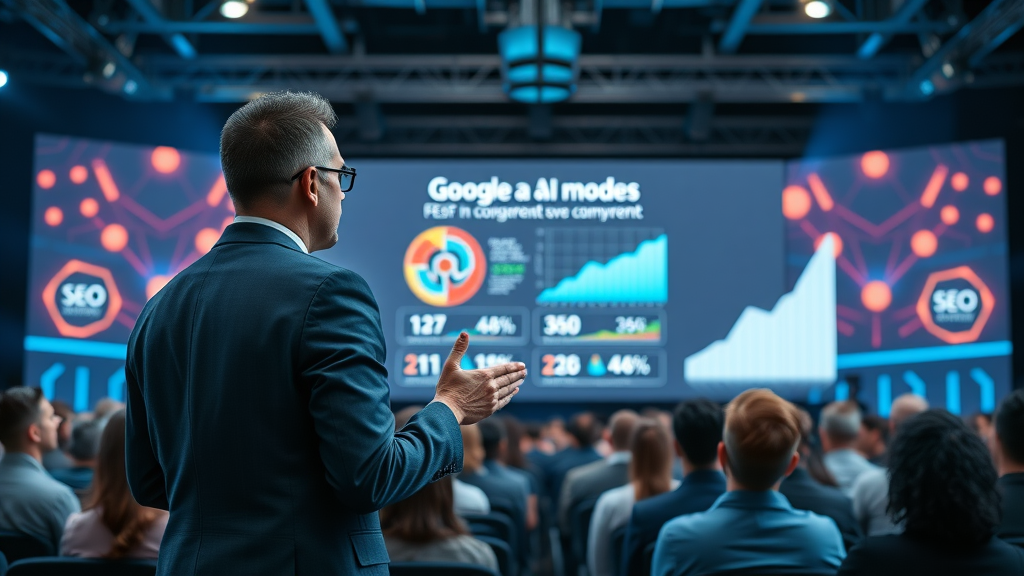Did you know that over 60% of search queries on Google are now touched by Google AI mode? The digital world is transforming before our eyes, and if your content isn’t keeping up, it risks vanishing into obscurity. Google AI mode isn’t just a new feature—it’s a seismic shift in how information is found and consumed. In this article, I’ll break down the dizzying changes, spotlight what they mean for your visibility, and share how you can stay ahead in the age of AI-powered search engines . Whether you’re a marketer, publisher, or entrepreneur, mastering this new search landscape isn’t optional—it's essential.
For more information, go to https://cm2digitalenterprises.com/advanced-ai-seo .
The Paradigm Shift: Google AI Mode Is Changing How We Access Information
-
Did you know that over 60% of search queries on Google are now influenced by Google AI mode? This transformation is quietly reshaping everything from how content ranks to how users interact with search engines. The rise of ai mode means visibility strategies must evolve or risk extinction.

The digital landscape is witnessing a paradigm shift as Google AI mode quietly asserts its dominance. The days when simple keyword matching determined your place in search results are over. Now, AI features shape which information is surfaced, how it’s displayed, and even how users experience search. If over half of all queries are already influenced by AI, then traditional SEO strategies require urgent evolution. This new search ecosystem means that marketers, content creators, and brands must double down on agility and relevance to stay visible.
Failure to adapt to the “ AI mode ” influx could leave your content buried—quite literally—under layers of AI-curated insights and AI overviews . The good news? Those who learn to navigate this landscape can benefit from visibility that would have been nearly impossible in the old search era. The surge in AI-first curation propels authoritative content forward, pushing generic or shallow results to the wayside. In essence, the bar has been raised, but so have the rewards for those ready to leap.
Understanding Google AI Mode and Its Game-Changing Role
What Is Google AI Mode? A Foundation for the New Search Model
Google AI mode is much more than a technological upgrade; it is a revolutionary approach that fundamentally reimagines information discovery on the web. Powered by leading-edge generative AI and advanced language models , this mode interprets complex queries, surfaces context-rich answers , and anticipates the user’s needs beyond what traditional algorithms allow. No longer does the search engine merely return matched keywords—it now “understands” user intent, delivers summarized insights, and even breaks a single question into subtopics for comprehensive answers.
The foundation of Google AI mode combines advanced reasoning with machine learning, enabling smarter search experiences through dynamic features like AI overviews and enhanced search labs experiments. As Google continues to develop and iterate upon this model—including specialized modes like AI Pro and AI Ultra —the way we consume, create, and optimize content for discovery will keep evolving. To stay ahead, understanding these AI-driven foundations is non-negotiable.
How Is Google AI Mode Different from Traditional Search?
The gap between traditional search and Google AI mode is vast. In the past, users typed a query, and the search engine sifted through indexed pages based solely on keywords and backlinks. With AI mode, however, the search engine leverages generative AI to deliver synthesized answers, pull from a much broader context, and even anticipate follow-up questions—all in a matter of seconds. No more sifting endlessly through blue links or manually refining queries.
"AI overviews are leading a generational leap in how Google Search presents information, enabling users to get rapid, nuanced insights that traditional search could never match."
Unlike the “old school” search bar paradigm, where specific keywords ruled, AI-powered search can interpret queries in natural language, link concepts seamlessly, and display results in interactive components. This shift requires content creators to move beyond stuffing keywords, instead focusing on building deep, connected, and flexible content ecosystems that are as readable for AI as they are for humans.
Why Google AI and Generative Engine Optimization Are Reshaping SEO
The Intersection of Google AI Mode and Generative AI
Generative AI has rapidly become the secret sauce behind Google’s reimagined search experience. By blending Google’s years of search engine data with the pattern-identifying prowess of AI mode , the new model can produce original, nuanced content and surface “ AI overviews ” that synthesize multiple sources into a single result. This means the traditional SEO focus on matching keywords is now dwarfed by the need to answer intent—in context and with clarity.
Because Google AI mode leverages generative models that learn from thousands of previous searches, it can refine results on the fly, cater to unique user preferences via the Google app , and respond to evolving linguistic trends. In short, search is now less about finding “matches” and more about “understanding”—rewarding sites that meet queries with real thought leadership and comprehensive answers.
Generative Engine Optimization vs. Traditional Engine Optimization: What’s Different?
Whereas traditional engine optimization hinged on tactics like link building and keyword density, the AI era is ushering in generative engine optimization —a strategy that emphasizes context, semantic connections, and structured data. Sites hoping to succeed in Google AI mode must now design content that adapts to fluid AI features : think layered answers, multimedia support, and data transparency.
Generative engine optimization fine-tunes the content for how AI features analyze relevance and present information. This means leveraging entity-based structure, answering multiple subtopics in one response, and embedding sources that AI can reference to improve user trust. Failing to evolve means being leapfrogged by competitors already experimenting through search labs and monitoring what AI Pro and Ultra suggest for content formats.
|
|
|
Traditional Search vs. Google AI Mode & Generative Engine Optimization |
|
Criteria |
Traditional Search |
Google AI Mode & Generative Engine Optimization |
|---|---|---|
|
Speed |
Slower; relies on manual query refinement and multiple searches. |
Faster; generates synthesized answers instantly, even to broad questions. |
|
Content Depth |
Surface-level; keyword matches dominate, context often missed. |
Deep; addresses questions into subtopics, provides layered context. |
|
Context Awareness |
Limited; minimal understanding of user intent or related topics. |
High; advanced reasoning, adapts to nuance, less reliant on exact match. |
|
User Experience |
List of blue links; users must sift for answers. |
Interactive; answers, visuals, conversational summaries. |

How AI Features in Google Search Impact User Interaction and Visibility
The Role of AI Features, AI Overviews, and Google App in Search Results
AI features like AI overviews and even mobile enhancements within the Google app are fundamentally altering how users engage with search. Instead of scanning a dozen blue links, users now receive summarized, “conversational” answers—often with option-rich follow-up suggestions. These AI overviews distill multiple viewpoints, reference specific sources, and highlight direct action items, reducing the time from query to solution.
For brands and publishers, this creates a double-edged opportunity: You can gain prominent placement as a referenced source in an AI summary, or get bypassed if your content lacks clear structure and depth. Making your site visible in the Google AI mode ecosystem means anticipating what the AI will surface, structuring your information to be easily parsed, and aligning it with the experiential features found in the latest Google app interfaces.
How Google AI Ultra and AI Pro Modes Change SERP Appearances
The introduction of advanced models like Google AI Pro and AI Ultra has made the search results page (SERP) nearly unrecognizable. Instead of static text and ad-heavy layouts, AI-powered search surfaces carousels, interactive charts, multimedia, and layered content from multiple authoritative voices. Thanks to these new ai modes , users receive insights contextualized for their preferences and even device type.
To secure visibility with these upgraded SERPs, your content must be AI-ready : formatted with structured data, responsive to voice and mobile, and bolstered by expert perspectives that train the AI models. The more your expertise aligns with what the AI recognizes as valuable, the more likely you are to get featured, even as Google AI Ultra and others continue refining the SERP experience.
Adapting Your Content Strategy to Succeed in Google AI Mode
Essential Tips for Getting Featured in Google AI Mode Results
-
Write for Human+AI Audiences: Ensure your content is authoritative, readable, and structured for parsing by both people and algorithms.
-
Emphasize Contextual Relevance: Dive into the “why” and “how” behind answers; link related topics and anticipate follow-ups.
-
Optimize for Generative Engine Queries: Use structured data, address subtopics, and provide clear, expert-backed insights.
-
Leverage Structured Data for Better AI Comprehension: Add schema markup to help the AI understand relationships, intent, and credibility.

By prioritizing both generative engine optimization and readability, your content stands a far better chance of being surfaced in Google AI mode . Remember: Google’s AI wants to showcase answers that are both reliable and immersive, which means depth, nuance, and expert sourcing beat superficial keyword stuffing every time.
Continuous experimentation through Search Labs and close monitoring of new AI features is the only way to ensure your optimization strategies remain ahead of the curve. Those adapting fastest—embracing structured data, updating for new ai overviews , and leveraging interactive formats—are seeing the biggest boosts in search visibility .
Why Google Search Labs and AI Features Demand Content Experimentation
Google has made it clear: “Experiment in Search Labs” is not just a tagline, it’s a mandate for marketers and publishers who want continual relevance. Through search labs , novel AI features are soft-launched, tested, and refined based on user interaction. Those who dive in early can influence what works, gather real-time data on what drives AI responses , and iterate faster than laggards.
Embracing this experimental culture—by integrating feedback from search labs and monitoring how your content is summarized in AI overviews —can futureproof your optimization. As Google experiments with ever more sophisticated AI Pro and AI Ultra modalities, content creators must treat agility and experimentation as core components of their SEO philosophy.
Visual breakdown of how Google AI Mode interprets and displays search results compared to traditional search.
A compelling video demonstration will show how Google AI mode synthesizes a user’s complex question—breaking it into subtopics, drawing from authoritative sources, and surfacing a conversational overview in seconds. Contrast this with traditional search, which typically returns a list of links requiring further clicks and investigation. This visual side-by-side helps SEOs and content creators grasp the scope of change and confirms why optimization for AI features is urgent.
What You'll Gain from Mastering Google AI Mode
-
How Google AI mode interprets and ranks information
-
The core differences between AI-powered and traditional search results
-
Actionable strategies to optimize for Google AI mode
-
How to adapt to ongoing updates in Google AI features and search labs

Gaining mastery in Google AI mode futureproofs your visibility, helps you outpace competitors, and unlocks smarter, more meaningful engagement with your audience. The skills and insights shared here are your first steps toward reigning in an AI-first world.
Expert Perspectives: Quotes on Google AI Mode and Future Search Engines
"Those who adapt to Google AI mode early will set the benchmark for disruptive search performance in this new era." – Industry Analyst
Leading industry voices consistently reaffirm that the transition to AI-powered search is more than a passing trend—it’s the new backbone of content discovery and digital marketing. By heeding expert insight, you invest in strategies with lasting impact, not fleeting tricks.
Forecasting the Role of Google AI Pro, AI Ultra, and Future AI Modes
Anticipating the Next Steps in AI-Powered Generative Engine Optimization
As Google rolls out enhanced models like AI Pro and AI Ultra , expect a bigger shift toward hyper-personalized search results , context-rich multimedia overviews, and interactive features powered by deep language models . The next leaps will include better integration of video , real-time data mapping, and cross-platform synchronization—requiring businesses to double down on both technology and creativity.
Brands that wish to lead must treat generative engine optimization as an evolving craft. Experimenting with new data structures, monitoring AI mode experiments, and collaborating with AI specialists will define success in the future of engine optimization .
Implications for User Trust and Search Experience
As AI-generated content shapes more of the search page , building and maintaining user trust becomes paramount. Accurate citations, transparent data, and clear authorship will be critical in winning both user and algorithmic approval. This new reality puts pressure on marketers and publishers to raise editorial standards, invest in fact-checking, and lean into authentic expertise.

Thought leaders explain how search professionals are responding to the Google AI transformation.
Look for expert interviews and panel discussions analyzing how the industry adapts to evolving AI features , which skills are in demand, and which strategies drive the new gold standard for search visibility in the age of Google AI mode .
Addressing Common Questions: People Also Ask About Google AI Mode
What is Google AI mode?
-
Google AI mode is an advanced search technology leveraging generative AI to interpret user queries, generate context-rich answers, and showcase information beyond traditional keyword-matching. It powers many of Google Search's newest features, including AI overviews and personalized results through the Google app.
How do I turn on Google AI mode?
-
Google AI mode is activated by default in Search Labs or on select Google app experiences. To enable, users can join Search Labs (if available in your region) or use supported devices and update to the latest Google app.
How do I turn off Google AI mode?
-
Some features of Google AI mode can be toggled in Search Labs or through your Google account settings in the app. However, complete disabling may not be possible as AI enhancements become core to the Google Search experience.
How do I enable AI in my phone?
-
Ensure your Google app is up-to-date, join Search Labs if available, and follow prompts to enable experimental features like ai mode and generative search on your device.
FAQs on Google AI Mode and Search Engine Optimization
-
Does generative AI affect my website traffic?
Yes. Generative AI can redirect click traffic by providing direct answers, but sites with authoritative, well-structured content are more likely to be cited and linked from AI overviews, sustaining or even boosting their visits. -
What is the best way to optimize for Google AI mode?
Focus on deep, comprehensive coverage of topics, use schema markup, and ensure your content answers not just the immediate query but related subtopics as well. -
Can AI overviews hurt my rankings?
They can, if your content is shallow or not referenced by the AI. However, authoritative sources often benefit from higher visibility as AI summarizes and cites trustworthy pages. -
Will traditional SEO still matter?
Absolutely—technical SEO and quality content remain critical. However, strategy must evolve to include generative engine optimization and structured, AI-friendly formatting.
Key Trends in Google AI Mode: What Marketers and Publishers Must Know
-
Google AI mode impacts both ranking and presentation
-
Continuous updates demand agile content strategies
-
Early adopters reap disproportionate visibility benefits
-
Combining human insight with generative engine optimization delivers best results

Preparing for the Future: Remaining Visible Amid Google AI Mode's Ongoing Evolution
Actionable steps to ensure your content and brand maintain visibility and relevance:
-
Monitor updates in google ai and google ai mode
-
Experiment with AI features and search labs tools
-
Evolve your content for both users and generative engines
-
Collaborate with experts in engine optimization and generative ai
Demonstration of websites adapting content and seeing improved visibility through AI-focused strategies.
Discover how forward-thinking brands have experimented with new AI features —refining content structure, leveraging search labs, and optimizing for ai overviews —to achieve measurable gains in rankings and audience engagement. Short case studies and side-by-side comparisons show how small adjustments can deliver outsized results as Google AI mode advances.
Why Proactive Action in Google AI Mode Can Safeguard Your Online Presence
Delaying adaptation to ai mode could mean falling behind competitors and losing search visibility. Positioning for Google AI mode today is an investment in enduring digital relevance.
Waiting to pivot could mean your hard-earned rankings are displaced overnight. Get started now—experiment, optimize, and integrate AI-first thinking to ensure your brand stays ahead of the curve as Google AI mode , AI Pro , and future models rewrite the rules.
Conclusion
Embrace Google AI mode by tracking search trends, experimenting aggressively, and evolving your content for both human readers and generative engines—your digital visibility depends on it.
 Add Row
Add Row  Add
Add 




Write A Comment